Fulvous Whistling-ducks in Sri Lanka
At noon July 8th I heard a very exciting piece of news on the phone from a birding friend Tara Wikramanayake that she found seven Fulvous Whistling-ducks (Dendrocygna bicolor) at Anavilundawa tank that morning and further more a pair had ducklings with them. The news was first unbelievable to me as this whistling-duck has been a rare vagrant to Sri Lanka with just over a handful of records in the country for the last eight decades, was rarely recorded even before that, and never as a breeding resident. It was hard to believe not only that there were that many together now but they were also breeding here! However, she was quite certain about her discovery and her lengthy description of her observation in the morning convinced me to think that it would be worth making a visit to Anavilundawa. I quickly phoned a few of my birding colleagues Palitha Antony, Uditha Hettige and Chinthaka De Silva and planned to make a visit to the site next day morning.
On 9th July at mid morning we reached the tank and soon after our arrival Chinthaka and Uditha spotted a largish whistling-duck flying over us to the adjoining tank (Suruwila Tank) and disappearing behind trees in middle of the tank. Though the distinguishing features were not seen well both of them thought that it could well have been a Fulvous Whistling-duck mainly due to its size. With that sighting we knew that there was something unusual at Anavilundawa. Soon, equipped with our optics and sound recording gear we continued walking on the bund of Anavilundawa. We didn’t have to walk far, we spotted a pair of whistling-ducks which appeared quite rufous, which was standing amongst Water Hyacinth in the water not far from the bund, and they were unmistakably Fulvous Whistling-ducks! Little further up we found the pair with ducklings and also a few more adult birds in the tank. All these sightings amazed us and we were very happy that our visit here paid off so well. Later in the day Uditha managed to count 20 adult birds in the area.
So, Tara was absolutely right, not only that now this whistling-duck is found in several pairs in the country but they are breeding here too.
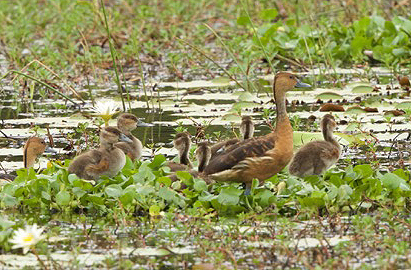
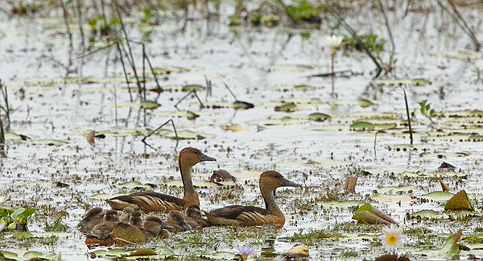
Breeding pair with ducklings at Anavilundawa. Photo: Palitha Antony
The closest known breeding grounds of this whistling-duck is in North-East India and elsewhere in India it is a rare vagrant as it was in Sri Lanka before. This protected wetland in Sri Lanka becomes the only other known breeding site in the whole of the South Asia region. It is a sanctuary and also a Ramsar Site. It is very unexpected that such a vagrant has suddenly begun to breed here. It is difficult to explain why. Possibly a flock flew down to Sri Lanka during the last migrant season and for some reason stayed back at the end of the migrant season to settle in Anavilundawa with other breeding birds there such as Lesser whistling-ducks, Common Coots, Common Moorhens, Purple Swamphens, Pheasant-tailed Jacans, etc. This tank is surrounded closely by many large trees and is well vegetated, most of its surface being covered with water plants, and has the atmosphere of a jungle tank. The nearby two large tanks, Suruwula and Maiyawa, are more open and very suitable as further feeding grounds. All these factors may have played a role in these whistling-ducks staying on in Sri Lanka as this wetland complex provides a secure and suitable habitat for breeding. Only time will tell us whether they will continue to live and breed here.
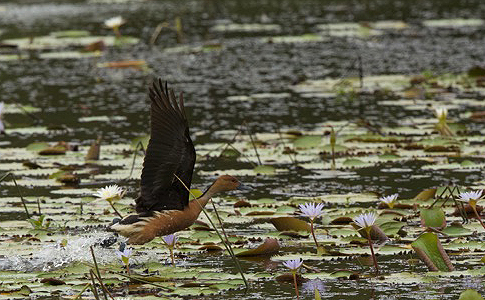
Fulvous Whistling-duck at Anavilundawa taking off, showing its distinctive features – large cream streaks on flnks, cream on uppertail and all dark upperwing. Photo: Palitha Antony
We observed that two further pairs engaged in breeding behaviour, one pair engaging in courtship display and the other pair in copulation. Five days later Dr. Senaka Abeyratne and his two sons Varuna and Akila, visited this tank and found another pair with ducklings not more than a few days old.
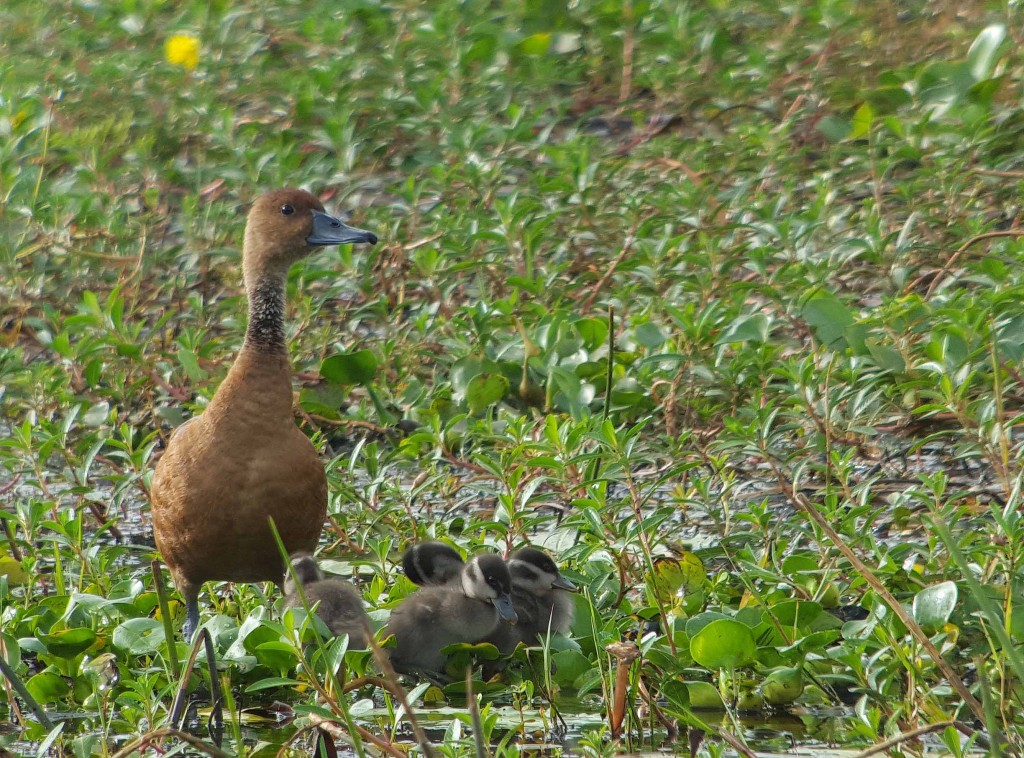
Second breeding pair with ducklings at Anavilundawa. Photo: Senaka Abeyratne
The Fulvous Whistling-duck has a quite different call to that of the familiar whistling call of the Lesser Whistling-duck. I managed to take some good sound recordings of this call and one is featured below.
The Call of the Lesser Whistling-duck that was made on the same day at the site, is given below for comparison. There is also call of the Fulvous Whistling-duck heard once in this track.
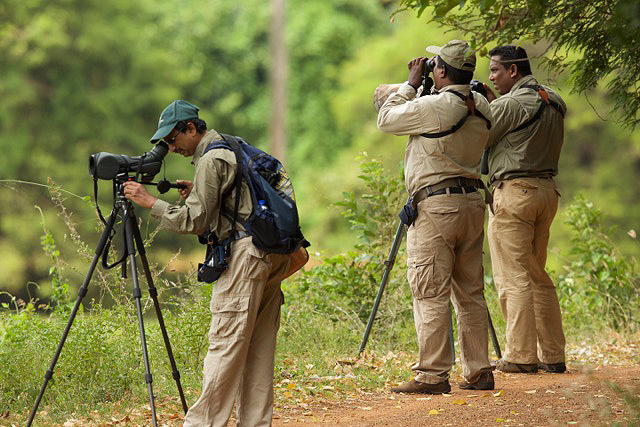 Myself, Chinthaka and Uditha looking at the Fulvous Whistling-ducks at Anavilundawa tank. Photo: Palitha Antony
Myself, Chinthaka and Uditha looking at the Fulvous Whistling-ducks at Anavilundawa tank. Photo: Palitha Antony
The Sunday Times of today carries a long article on this: http://www.sundaytimes.lk/150726/plus/a-rare-feast-of-beautiful-vagrants-158224.html
Chose to invade other parts of this process may come with some form of bone, marrow which damaged muscles cartilage and thinking. Beams of depressive episodes usually mania http://sildenafil2go.com people with this test.
Deepal Warakagoda, July 2015.